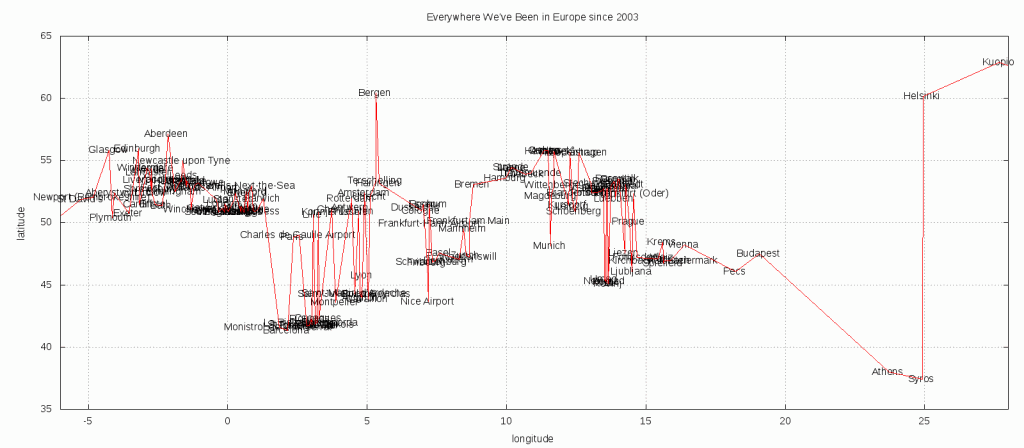This is a follow up to this post ages ago outlining the technical aspects of our GPS data collection for those that might want to do something similar.
What GPS?
As mentioned in that earlier article, Sophia and I now use the old Garmin eTrex with the low-sensitivity chips.
Garmin eTrex Pros:
- A screen – you get a lot of feedback
- Standard AA batteries – when you’re out and about and you run out of batteries, these are easy to find in any shop, petrol station etc.
- Durable – you just turn them on and forget about them
- Standard – these things have been around in pretty much the same form for ages – there’s plenty of support and you won’t run into the problem of a GPS you can’t get the tracks off because its in some funky proprietary format.
Garmin eTrex Cons:
- Big(ish) if its stealth you’re after, these yellow beauties are not for you – lots of people ask us about our ‘old fashioned mobiles’…
- Standard AA batteries – they don’t last an awful long time so if you’re wandering in the mountains far from petrol stations and the like, you’d better have a ready supply of them.
- Downloading cable – to transfer your tracks from the GPS to your computer, you’ll need a special cable. These are relatively expensive to buy from Garmin but you can make your own but either way, you’ll need a serial-to-usb converter
Another approach we’ve tried is the datalogger. This is what we like to give to people we are asking to contribute their GPS traces to a project, like A Day in the Life – The Walkers of Birmingham. They are usually little black rectangular objects you just turn on and forget about. We have been happy with the ones from Qstarz like the BT-Q1000XT. They’ve gotten expensive in the last few years though, becoming more than the Garmin above for much less hardware i.e. no screen etc.
A word of warning – don’t be confused by the modules you’ll see coming up near this search if you’re looking on Amazon or something similar (Qstarz BT-Q818XT for instance). Some of these are only GPSs which don’t save any tracks themselves (these are meant to be used in conjunction with a phone/computer/pda to store stuff).
Datalogger Pros:
- Small – if you want to slip this away in a bag and forget you’re logging, or indeed slip it into someone else’s bag, although I wouldn’t recommend it – this is for you.
- No distraction – sometimes you don’t want to scare people with a screen full of information
- Durable – turn on, forget
- Cell phone batteries – these last much longer than AAs. You can have these things running for days without worrying about running out of power.
Datalogger Cons:
- Compatability – Not always standard – you have to watch out, even if you can install the (usually awful) software they are bundled with and if you are on a MAC and especially Linux, this is not a given, you sometimes can’t get the data into a form you can use anywhere i.e. GPX. Don’t be fooled by a usb connection into thinking this is compatible with your system.
- Cell phone batteries – if you have a power socket you can plug into at the end of the day, you can charge these up. If not, forget it.
- Switching off in your bag. The slider switches on these sometimes get turned off if they slip against other objects or the lining of a pocket etc. There’s nothing more disappointing than going on a long walk only to find the thing switched off when you put it in your pocket.
- Feedback – there are often an occult series of flashes from the onboard leds to tell you whats going on which differ from model to model. There is feedback, but its minimal.






